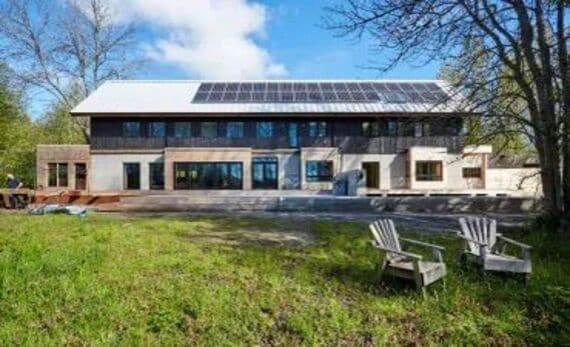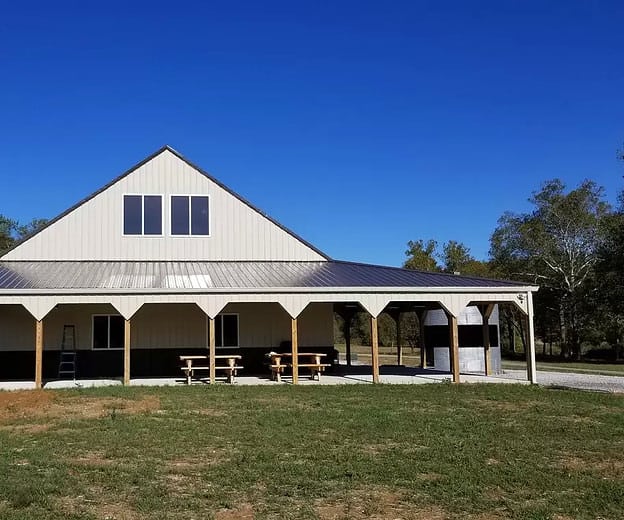Barndominiums are a popular housing trend that combines the convenience of a traditional barn with the comforts of a modern home. These structures are usually made from metal or steel, and they offer plenty of space for living, working, and storing equipment or vehicles. But are barndominiums as energy-efficient as conventional homes? In this article, we’ll explore the pros and cons of building and living in a barndominium, as well as some tips on how to maximize its energy efficiency.
Yes, barndominiums can be designed and built to meet or exceed energy efficiency standards for conventional homes. With the right materials, technologies, and practices, barndominiums can save you money and reduce your carbon footprint. However, like any other type of home, their energy efficiency depends on various factors, such as design, insulation, and HVAC systems. Lets take a deeper look.
What Makes Barndominiums Energy Efficient?
Barndominiums have some unique features that can contribute to their energy efficiency. For example, metal roofs and walls can reflect sunlight and prevent heat from building up inside the structure, reducing the need for air conditioning. Additionally, barndominiums can be designed to include plenty of natural light and ventilation, which can help reduce the use of artificial lighting and HVAC systems. Finally, many barndominiums are built with energy-efficient appliances, lighting fixtures, and insulation, which can significantly reduce energy costs.
Pros and Cons of Building a Barndominium
Like any housing option, barndominiums have their advantages and disadvantages. On the one hand, they offer plenty of space, flexibility, and durability, making them ideal for rural areas, farms, or businesses. They are also relatively affordable compared to traditional homes, especially if you are willing to do some of the construction work yourself. However, barndominiums may not be suitable for all climates or lifestyles. For example, they may not be as comfortable or aesthetically pleasing as a conventional home, and they may require different types of maintenance and upkeep due to their metal components.
Tips for Maximizing Barndominium Energy Efficiency
If you decide to build or live in a barndominium, there are some things you can do to make it more energy-efficient. First, choose the right location and orientation, taking into account the local climate, wind patterns, and sun exposure. Second, invest in high-quality insulation and weatherization materials to prevent heat loss or gain. Third, install energy-efficient windows, doors, and lighting fixtures that can reduce energy consumption. Fourth, consider using renewable energy sources such as solar panels, wind turbines, or geothermal systems to power your barndominium. Finally, adopt energy-saving habits such as turning off lights and appliances when not in use, using programmable thermostats, and minimizing water usage.

Frequently Asked Questions about Barndominium Energy Efficiency
Q1: Can barndominiums be as energy-efficient as conventional homes?
A1: Yes, barndominiums can be designed and built to meet or exceed energy efficiency standards for conventional homes. With the right materials, technologies, and practices, barndominiums can save you money and reduce your carbon footprint.
Q2: How much does it cost to make a barndominium energy-efficient?
A2: The cost of making a barndominium energy-efficient can vary depending on several factors such as the size of the structure, the level of insulation and weatherization, the type of windows and doors, and the use of renewable energy sources. However, the upfront investment can pay off in the long run, as you can save on energy bills and increase the resale value of your property.
Q3: Are barndominiums more expensive to build than traditional homes?
A: The cost of building a barndominium can vary widely depending on factors such as location, size, materials, and finishes. However, in general, barndominiums can be a more cost-effective option than traditional homes due to their simpler design and construction process. Additionally, because barndominiums are highly customizable, homeowners can choose to use more affordable materials and finishes, or splurge on high-end options depending on their budget. Ultimately, building a barndominium can be a great way to save money while still achieving a unique and energy-efficient living space.
Q4: What are the most energy-efficient materials for building a barndominium?
A4: When it comes to building an energy-efficient barndominium, choosing the right materials is crucial. Here are some of the most energy-efficient materials to consider:
| Material | Description |
|---|---|
| Insulated Concrete Forms (ICFs) | ICFs are hollow foam blocks or panels that are stacked together to form the walls of a building. They are highly energy-efficient due to their airtightness and insulation value. |
| Structural Insulated Panels (SIPs) | SIPs are made up of a layer of foam insulation sandwiched between two panels of oriented strand board (OSB). They provide excellent insulation and are easy to install. |
| Insulated Vinyl Siding | Insulated vinyl siding can improve a barndominium’s energy efficiency by providing an additional layer of insulation over the exterior walls. |
| Low-E Windows | Low-emissivity (Low-E) windows have a thin coating that reflects infrared light, helping to keep heat inside during the winter and outside during the summer. |
| Radiant Barrier Insulation | Radiant barrier insulation is a reflective material that is installed in the attic or on the underside of the roof. It helps to reduce heat gain in the summer and heat loss in the winter. |
| Metal Roofing | Metal roofing is a durable and long-lasting option that can help to reduce energy costs by reflecting sunlight and preventing heat buildup in the attic. |
By incorporating these energy-efficient materials into the design of a barndominium, homeowners can significantly reduce their energy consumption and save money on utility bills.
Conclusion
In conclusion, building a barndominium can be a great way to achieve a unique and energy-efficient living space. By choosing the right materials and incorporating energy-saving features into the design, homeowners can significantly reduce their energy consumption and save money on utility bills. Barndominiums are highly customizable, allowing homeowners to choose affordable materials or splurge on high-end options depending on their budget. Whether you’re looking for a full-time residence or a vacation home, a barndominium can be a smart and stylish choice that is both energy-efficient and cost-effective.
Thank you for reading this comprehensive guide on building an energy-efficient barndominium. We hope you found this information useful and informative. If you have any further questions or would like to learn more about building a barndominium, please don’t hesitate to reach out to a professional contractor or architect for guidance or you can call email me directly



Recent Comments